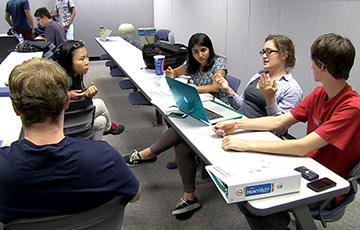Flipping Your Class - Active Learning
There are multiple ways instructors can integrate active learning into their classes. U-M faculty who have flipped their class have used a wide range of active learning techniques. For example, Tami Remington (Pharmacy) has her students discuss clinical vignettes in groups of 6-7 students, while Steve Skerlos (Engineering) has his students working in groups on longer-term projects for the course. Instructors do not need to create longstanding student groups to engage their students in active learning, though. This active learning continuum graphically represents the relative complexity of different active learning techniques. It also provides brief descriptions for each of the activities on the continuum. Some of these techniques (for example, the think-pair-share) require minimal preparation on the part of the instructor and can be implemented in the moment if you recognize that students need some additional processing time to understand the concept being addressed in class. This video of Deborah Ball, School of Education, demonstrates one way active learning can be implemented in a lecture class.
their class have used a wide range of active learning techniques. For example, Tami Remington (Pharmacy) has her students discuss clinical vignettes in groups of 6-7 students, while Steve Skerlos (Engineering) has his students working in groups on longer-term projects for the course. Instructors do not need to create longstanding student groups to engage their students in active learning, though. This active learning continuum graphically represents the relative complexity of different active learning techniques. It also provides brief descriptions for each of the activities on the continuum. Some of these techniques (for example, the think-pair-share) require minimal preparation on the part of the instructor and can be implemented in the moment if you recognize that students need some additional processing time to understand the concept being addressed in class. This video of Deborah Ball, School of Education, demonstrates one way active learning can be implemented in a lecture class.
When considering flipping your class, know that the "flip" does not need to be an all-or-nothing adventure. Depending on the instructor’s goals and comfort level, the amount of time spent on active learning within a single class session may vary. Instructors may choose to implement a partial flip, where a significant portion of lecture is replaced by active learning, such as discussions of case studies or working on applied problems in small groups. In such a partial flip, instructors still lecture as part of the course delivery during the class session, but active learning is also used extensively to achieve specific learning goals. For example, instructors may lecture at the beginning of a class meeting or between activities, to clarify or synthesize the most difficult concepts, but still devote most of the class time to active learning.
 Flipped classrooms vary not only in the amount of active learning per class meeting, but also in the number of class meetings per course that contain active learning. An instructor might replace just a few lectures within the course and use active learning throughout those class periods so that students can process particularly challenging concepts in class. Typically, these topics are ones that students have historically struggled with, and this type of exercise would provide them additional in-class practice and feedback.
Flipped classrooms vary not only in the amount of active learning per class meeting, but also in the number of class meetings per course that contain active learning. An instructor might replace just a few lectures within the course and use active learning throughout those class periods so that students can process particularly challenging concepts in class. Typically, these topics are ones that students have historically struggled with, and this type of exercise would provide them additional in-class practice and feedback.
Additional resources about active learning provide ideas for implementing active learning in your class as well as evidence for the impact of active learning on students' understanding of course content.
| Low-Tech | High-Tech |
|---|---|
|
|
